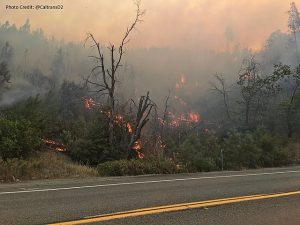by Leslie Layton
The Shasta County Carr Fire, with its towering, tornado-like flames tearing into the city of Redding, is the kind of summer fire that could cease to be an anomaly as climate change reshapes the Northern California environment, said Mark Stemen, a professor in the Chico State Geography and Planning Department.

It’s also the kind of fire that this city must work to prevent, said Stemen in a telephone interview Friday. “A fire like this could absolutely happen in Chico if the winds were strong and blowing down the canyon,” Stemen added in an email to ChicoSol.
“One of the things that climate change has done is extended the fire season and created these inferno flames,” Stemen said. “The Carr Fire is a climate-change enhanced fire because of the extreme heat and the extreme winds.”
Stemen, a specialist in regional climate change and chair of the city’s Sustainability Task Force, noted that we’re already experiencing more hot days in the valley and seeing reduced mountain snowpack. Warmer temperatures are drying vegetation and creating windier conditions that contribute to “inferno flames that jump 40 feet,” he said.
“This is a new normal,” Stemen said, warning that events that were once considered extreme will become commonplace as the effects of climate change advance. “One way to think about it — but it’s kind of scary – is current extremes will become future averages. The scariest fire we have ever seen is going to be the kind of fire we see more often.”

Fire season in this area was traditionally from June to October. “The season is getting longer, and in the future we’ll just have year-round fire season,” Stemen said.
Stemen said there’s a lot the city can do to plan for these changes, from opening cooling centers to re-examining development planned for the foothills.
Media outlets often report on how fires started, but the conditions that are making the fires so deadly aren’t always understood. Chico has an environment in some ways similar to the environment hosting the fast-moving Carr Fire. “Here in Chico, we have Big Chico Creek in a ravine that gets wind and extends right down into our urban core,” Stemen noted. “If we’re not careful, it could dry out and turn into fire fodder.”
The fire in Upper Park in Chico earlier in July was brought under control quickly because, Stemen said, “Fortunately for us it was a calm day and there wasn’t a lot of wind.”
Leslie Layton is editor of ChicoSol.

Little Chico Creek, flowing through the center of the urban area, contains unmanaged jungles of Arundo (giant reed) that drys out and becomes potential tinder for rapid flame production. Arundo has greatly increased the fuel load in this neglected stream bed. In addition to a well-ventilated, tall structure Arundo stands always have large amounts of dry leaves, primary and secondary leaves that drop off canes as they grow. Arundo can burn any time of the year under varying conditions. If one of these patches of thick vegetation ignites during a north wind event the creekside buildings of Chapmantown will probably catch fire and blast through our southern urban area. The extreme heat and extended fire season that our region is enduring exacerbates the danger.
I hope more people in the North State read this, particularly those few who are still not convinced of climate change.